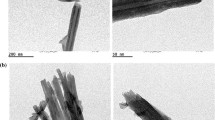Abstract
The effects of urea and urea-modified halloysite nanotubes (HNT) on structure and properties of poly(ɛ-caprolactone) (PCL) were evaluated using mechanical testing combined with FTIR, DSC, DMA, and various microscopic techniques. The results indicate important changes in mechanical behavior by urea-mediated interchain hydrogen bonding in PCL, whereas no linking between PCL and HNT in the related nanocomposite was found. As a result, the improved mechanical behavior of nanocomposites with urea-modified HNT was caused by combination of the matrix modification and urea-aided enhanced dispersion of HNT. The additives do not have any marked effect on PCL crystallinity. HNT increases and urea reduces the overall rate of crystallization. Both additives show a moderate nucleating effect.












Similar content being viewed by others
References
Woodruff MA, Hutmacher DW. The return of a forgotten polymer: polycaprolactone in the 21st century. Prog Polym Sci. 2010;35:1217–56.
Labet M, Thielemans W. Synthesis of polycaprolactone: a review. Chem Soc Rev. 2009;38:3484–504.
Wu D, Zhang Y, Yuan L, Zhang M, Zhou W. Viscoelastic interfacial properties of compatibilized poly (ε-caprolactone)/polylactide blend. J Polym Sci B Polym Phys. 2010;48:756–65.
Maglio G, Migliozzi A, Palumbo R, Immirzi B, Volpe MG. Compatibilized poly(ε-caprolactone)/poly(l-lactide) blends for biomedical uses. Macromol Rapid Commun. 1999;20:236–8.
Choi N-S, Kim C-H, Cho KY, Park J-K. Morphology and hydrolysis of PCL/PLLA blends compatibilized with P(LLA-co-CL) or P(LLA-b-CL). J Appl Polym Sci. 1992;86:1892–8.
Rao RU, Suman KNS, Rao VK, Bhanukiran K. Study of rheological and mechanical properties of biodegradable polylactide and polycaprolactone blends. Int J Eng Sci Technol. 2011;3:6259–65.
Chen Q-H, Li X-F, Lin J-H. Preparation and properties of biodegradable bamboo powder/polycaprolactone composites. J For Res. 2009;20:271–4.
Neppalli R, Marega C, Marigo A, Bajgai MP, Kim HY, Causin V. Improvement of tensile properties and tuning of the biodegradation behavior of polycaprolactone by addition of electrospun fibers. Polymer. 2011;52:4054–60.
Fukushima K, Tabuani D, Camino G. Nanocomposites of PLA and PCL based on montmorillonite and sepiolite. Mater Sci Eng C. 2009;29:1433–41.
Chen B, Evans JRG. Poly(ε-caprolactone)-clay nanocomposites: structure and mechanical properties. Macromolecules. 2006;39:747–54.
Ludueña LN, Vázquez A, Alvarez VA. Effect of the type of clay organo-modifier on the morphology, thermal/mechanical/impact/barrier properties and biodegradation in soil of polycaprolactone/clay nanocomposites. J Appl Poly Sci. 2013;128:2648–57.
Istrate OM, Chen B. Porous exfoliated poly(ε-caprolactone)/clay anocomposites: preparation, structure, and properties. J Appl Polym Sci. 2012;125:102–12.
Di Maio E, Iannace S, Sorentia L, Nicolais L. Isothermal crystallization in PCL/clay nanocomposites investigated with thermal and rheometric methods. Polymer. 2004;45:8893–900.
Alateyah AI, Dhakal HN, Zhang ZY. Processing, properties, and applications of polymer nanocomposites based on layer silicates: a review. Adv Polym Technol. 2013. doi:10.1002/adv.21368.
Du M, Guo B, Jia D. Newly emerging applications of halloysite nanotubes: a review. Polym Int. 2010;59:574–82.
Handge UA, Hedicke-Höchstötter K, Altstädt V. Composites of polyamide 6 and silicate nanotubes of the mineral halloysite: influence of molecular weight on thermal, mechanical and rheological properties. Polymer. 2010;51:2690–9.
Lee K-S, Chang Y-W. Thermal, mechanical, and rheological properties of poly(ε-caprolactone)/halloysite nanotube nanocomposites. J Appl Polym Sci. 2013;128:2807–16.
Khunova V, Kristof J, Kelnar I, Dybal J. The effect of halloysite modification combined with in situ matrix modifications on the structure and properties of polypropylene/halloysite nanocomposites. Express Polym Lett. 2013;7:471–9.
Guo Q, Groeninckx G. Crystallization kinetics of poly(ε-caprolactone) in miscible thermosetting polymer blends of epoxy resin and poly(ε-caprolactone). Polymer. 2001;42:8647–55.
Frisch MJ, Trucks GW, Schlegel HB, Scuseria GE, Robb MA, Cheeseman JR, Scalmani G, Barone V, Mennucci B, Petersson GA, Nakatsuji H, Caricato M, Li X, Hratchian HP, Izmaylov AF, Bloino J, Zheng G, Sonnenberg JL, Hada M, Ehara M, Toyota K, Fukuda R, Hasegawa J, Ishida M, Nakajima T, Honda Y, Kitao O, Nakai H, Vreven T, Montgomery JA Jr, Peralta JE, Ogliaro F, Bearpark M, Heyd JJ, Brothers E, Kudin KN, Staroverov VN, Kobayashi R, Normand J, Raghavachari K, Rendell A, Burant JC, Iyengar SS, Tomasi J, Cossi M, Rega N, Millam JM, Klene M, Knox JE, Cross JB, Bakken V, Adamo C, Jaramillo J, Gomperts R, Stratmann RE, Yazyev O, Austin AJ, Cammi R, Pomelli C, Ochterski JW, Martin RL, Morokuma K, Zakrzewski VG, Voth GA, Salvador P, Dannenberg JJ, Dapprich S, Daniels AD, Farkas Ö, Foresman JB, Ortiz JV, Cioslowski J, Fox DJ. Gaussian 09, Revision C.01. Wallingford, CT: Gaussian Inc.; 2010.
Merrick JP, Moran D, Radom L. An evaluation of harmonic vibrational frequency scale factors. J Phys Chem A. 2007;111:11683–700.
Horváth E, Kristóf J, Kurdi R, Makó É, Khunová V. Study of urea intercalation into halloysite by thermoanalytical and spectroscopic techniques. J Therm Anal Calorim. 2011;105:53–9.
Sumita M, Sakata K, Asai S, Miyasaka K, Nakagawa H. Dispersion of fillers and the electrical conductivity of polymer blends filled with carbon black. Polym Bull. 1991;25:265–71.
Wang J, Cheung MK, Mi Y. Miscibility and morphology in crystalline/amorphous blends of poly(caprolactone)/poly(4-vinylphenol) as studied by DSC, FTIR, and solid state NMR. Polymer. 2002;43:1357–64.
Cai N, Dai Q, Wang Z, Luo X, Xue Y, Yu F. Toughening of electrospun poly(l-lactic acid) nanofiber scaffolds with unidirectionally aligned halloysite nanotubes. J Mater Sci. 2014;. doi:10.1007/s10853-014-8703-4.
Liu M, Guo B, Du M, Jia D. Drying induced aggregation of halloysite nanotubes in polyvinyl alcohol/halloysite nanotubes solution and its effect on properties of composite film. Appl Phys A Mater. 2007;88:391–5.
Acknowledgements
This work was supported by the Czech Science Foundation (Grant No 13-15255S) and Slovak Scientific Grant Agency (VEGA) Grant No. 1/0361/14. The support of the TÁMOP-4.1.1.C-12/1/KONV-2012-0017 project in the nanocomplex preparation is also gratefully acknowledged.
Author information
Authors and Affiliations
Corresponding author
Rights and permissions
About this article
Cite this article
Khunová, V., Kelnar, I., Kristóf, J. et al. The effect of urea and urea-modified halloysite on performance of PCL. J Therm Anal Calorim 120, 1283–1291 (2015). https://doi.org/10.1007/s10973-015-4448-9
Received:
Accepted:
Published:
Issue Date:
DOI: https://doi.org/10.1007/s10973-015-4448-9




